The 2016-2017 China National Image Global Survey was jointly released on January 5, 2018 by the Academy for Contemporary China-World Studies (former Centre for International Communication Studies under the China Foreign Languages Publishing Administration), Kantar and Kantar Profiles. The annual survey, which was the fifth in this series, interviewed citizens of 22 countries, covering Asia (China, Japan, South Korea, India, Indonesia and Saudi Arabia), Europe (the UK, France, Germany, Italy, Russia, Turkey, Spain and Holland), North America (the US, Canada and Mexico), South America (Brazil, Argentina and Chili), Oceania (Australia) and Africa (South Africa). With 500 respondents from each country, a total of 11,000 respondents selected from the global panel of Lightspeed Research were included in this survey
Trying to present a comprehensive view about China, the survey polled the global respondents on China’s overall image and influence, and its images related to politics, diplomacy, economy, culture, science and technology since 2016.
Main findings of this survey include:
China’s overall image is steadily improving internationally
China scores 6.22 on the 10-point system of its overall image, maintaining a slight upward curve in recent years. Generally, developing countries had better impressions of China than developed countries, but China’s image improved more in developed countries than developing ones. Compared with 2015, the three countries whose score of China rose the most were all developed countries: Italy (up 0.5 point), Canada (up 0.4 point) and the UK (up 0.4 point).
(All charts are based on 10,500 overseas samples, unless stated otherwise)
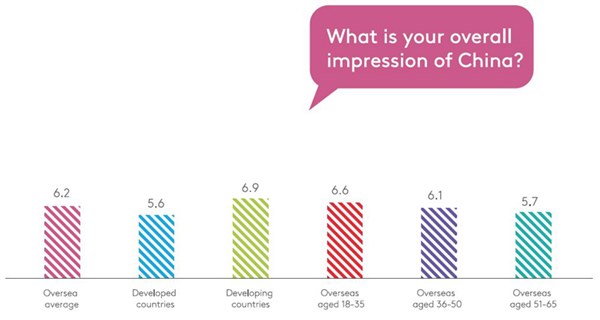
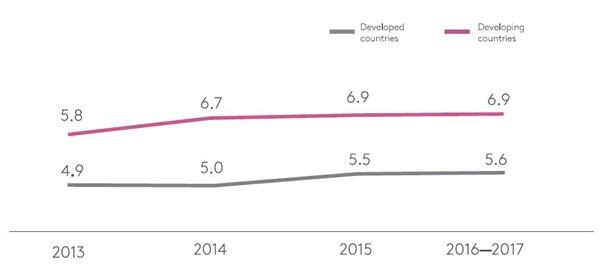
A big oriental country with a rich history, a contributor to global development
A big oriental country with a rich history and full of charm: This was the most impressive image of China in the eyes of overseas respondents (57%), those in developed countries, in particular. Nearly 40% of the overseas respondents recognized China’s contribution to global development, and the figure was nearly 50% in developing countries (48%).
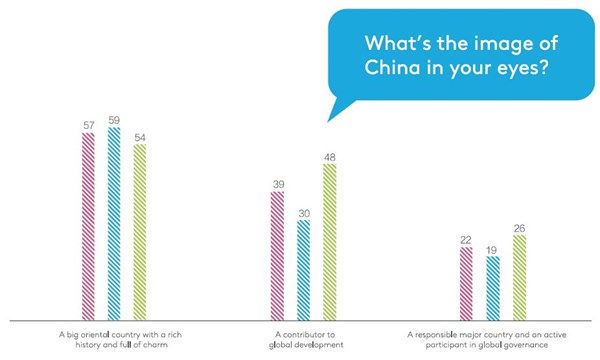
Overseas respondents are optimistic about China’s future development. Those in developed and developing countries both believed that China’s international status and global influence would continue to grow, and that China would lead the new round of globalization and contribute more to global governance.
An increasing number of overseas respondents –17% in 2013, 20% in 2014 and 24% in 2015 –thought that China would become the world’s largest economy, and the proportion was 33% in Survey 2016-2017. This showed that the international community had more confidence in China’s economic prospects.
There were still people, 36%, who agreed that China still faces such challenges as economic disparity and environmental pollution.
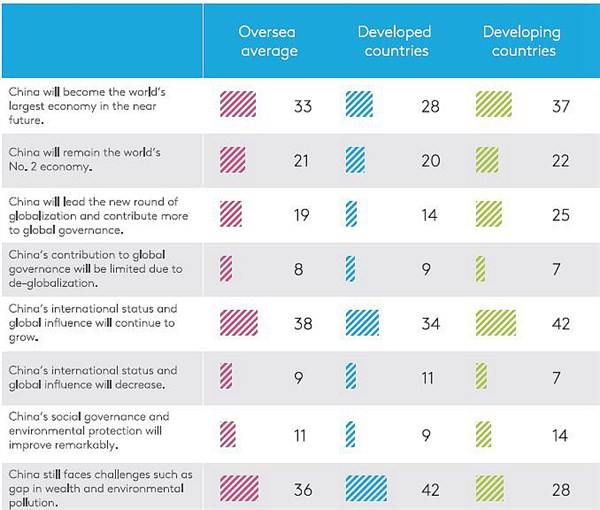
Belt and Road Initiative is highly praised
In Survey 2014, only 6% of the overseas respondents had heard of both the “Silk Road economic belt” and the “21st century maritime Silk Road”. The ratio rose to 18% in Survey 2016-2017, and was as high as 40% in Indonesia, India and other countries situated along the routes.
Most of the respondents thought that the Initiative is significant to their countries and themselves, to regional and global economy, and to global governance. Those in developing countries and the youth welcomed the Initiative more.
Relatively positive reaction to China’s growing economic influence
China’s economic influence ranks second in the world, next only to the US.
Similar to the previous survey, overseas respondents overall thought that China’s economic development promotes global economic development, that China is willing to cooperate with others in economy and trade, and that their countries have benefited from China’s economic growth. Developing countries’ comments on China’s economic influence were more positive than developed countries.

In the eyes of overseas respondents, Chinese enterprises’ entry and presence brings along new capital and technologies, and creates job opportunities to other countries.
Compared with the previous survey, there was a notable drop (-10 percentage points) in the number of people who feared about the negative effect of the Chinese enterprises on the development of local firms and brands.
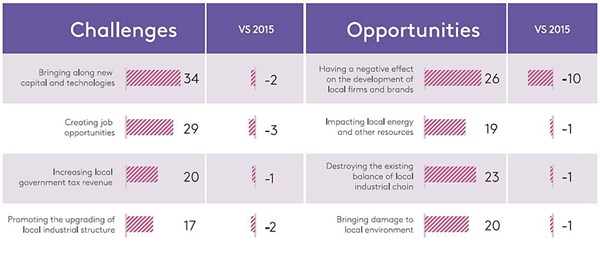
Traditional brands enjoy higher popularity
Lenovo, Huawei, Alibaba, Air China (up 2 notches) and Bank of China (up 6) are the five most renowned Chinese brands among overseas respondents. Compared with the previous survey, Bank of China, BYD (up 7) and other brands of traditional industries gained in popularity.
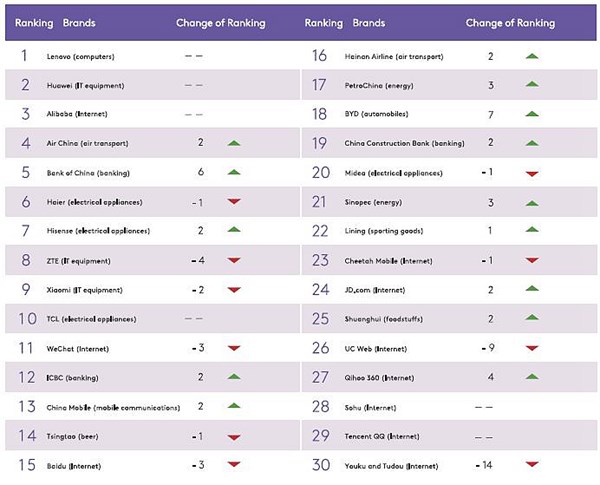
Cuisine best represents Chinese culture, high-speed rail most recognized high-tech achievement
Speaking of the elements that best represent Chinese culture, 52% of the overseas respondents chose cuisine, 47% ticked traditional Chinese medicine, and 44% marked off martial arts.
Overseas and Chinese respondents held different views in this regard. Compared with the Chinese themselves, the overseas respondents had a much lower recognition of Confucius and Confucianism (Chinese 62% vs foreign 26%), classics (55% vs 22%), and folk show and acrobatics (36% vs 16%), but had a higher recognition of Chinese products and scientific inventions.
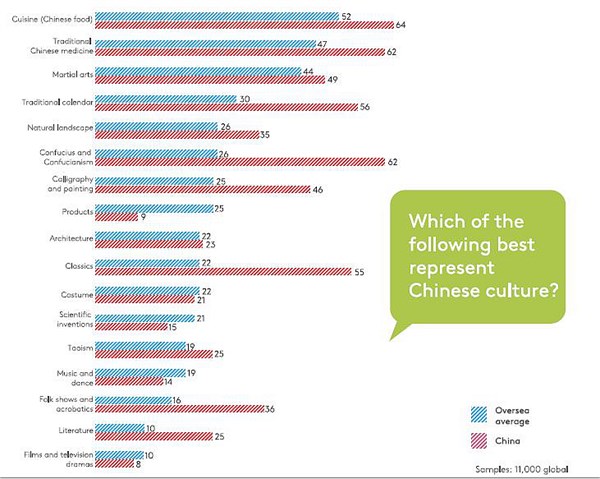
About 59% of the overseas respondents made a positive assessment of China’s technological innovation capacity, and the proportion was as high as 71% in developing countries.
High-speed rail (36%) was China’s best known technological achievement, followed by manned space flight (19%) and supercomputer (16%).
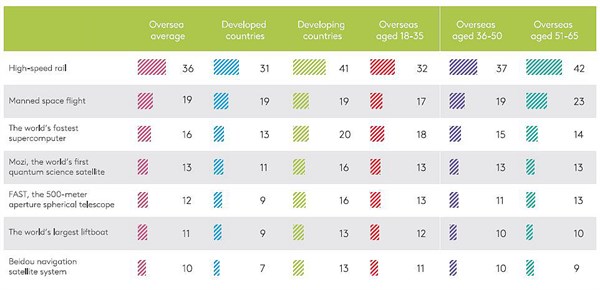
Interest in visiting China
Of the overseas respondents, nearly 30% planned to study, work or travel in China in the next three years. The proportion was nearly 40% in developing countries, with the top four being Indonesia (60%), Saudi Arabia (52%), India (51%) and Russia (41%).
Beijing (38%), Hong Kong (27%) and Shanghai (25%) were the three most favoured Chinese cities among the overseas people. This was generally the same as in the previous survey. More cities were gaining potential visitors, showing an increasing diversity in their destinations.
Editors notes
About the Platform of China’s National Image Survey
The platform of China’s national image survey is jointly developed by the Center for International Communication Studies under the China Foreign Languages Publishing Administration, and Kantar, with the aim of gauging the opinions of the international community toward China through a scientific, objective, systemic and comprehensive survey, seeking the feedbacks of foreign nationals to the international communication on China’s national image, and providing targeted, comparable and viable recommendations for boosting the effect of China’s international communication activities.
Since 2011, the platform has conducted research on China’s national image on a yearly basis, and all the findings have been made public.
The survey was conducted by using online questionnaires and strictly followed the international standards for online polls. To ensure the representation of the countries involved, the samples were local residents aged between 18 and 65 years, and the ratio of men to women was 50:50.


